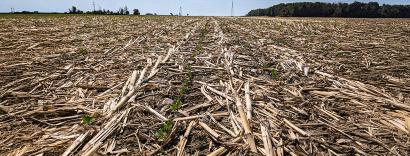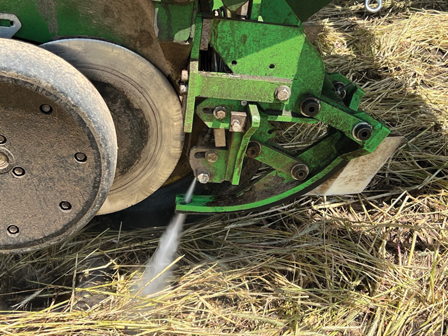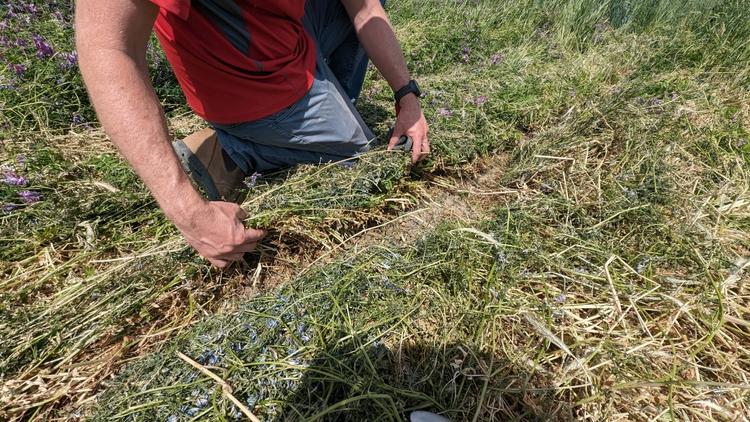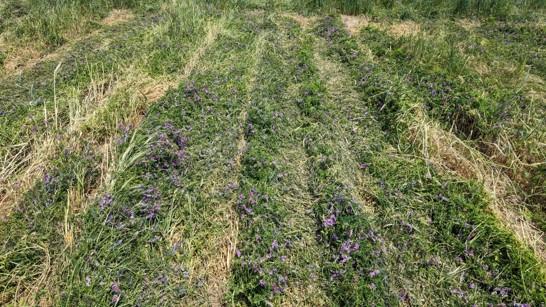
Cultivating Innovation—How Academic-Private Partnerships Are De-Risking Agri-Tech for Ontario Farmers
A conversation at the University of Guelph’s Sustainable Agri-Food Futures Event turned into an academic-industry collaboration that demonstrates the value of a new sustainable technology for Ontario cash croppers.
The venture between University of Guelph researcher Dr. Joshua Nasielski and Ontario-based ag-tech company Susterre Technologies Inc. was facilitated by the University’s Research Innovation Office. It’s a compelling example of how academic-private partnerships can drive innovation while reducing risk for farmers.
Published: July 11, 2025
Lead photo: A successfully planted field with dense crop residue.
Impact
This research demonstrates how academic-industry partnerships, with support from the Ontario Agri-Food Innovation Alliance, can de-risk innovation and support the adoption of sustainable practices in Ontario’s agri-food sector.
Agronomist Nasielski and Susterre CEO Michael Cully developed a plan to test a novel planter attachment designed to improve crop establishment in high-residue, no-till farming systems. Through trials at the Ontario Crops Research Centre sites in Winchester and Ridgetown, the project not only generated valuable third-party data for Susterre but also shows Ontario farmers how new technologies can support regenerative agriculture practices.
The Challenge: Planting Through Residue
Susterre Technologies developed a high-pressure water jet planter attachment to solve a common problem in no-till and cover crop systems: how to plant effectively through dense crop residue. In these systems, leftover plant material and living roots can act like “rebar” in the soil, making it difficult for traditional planters to operate efficiently.
“After corn harvest, you can have eight to 10 tons of residue per hectare,” explains Nasielski. “If you’re also growing cover crops, it’s even tougher. The soil is strengthened by living roots, and you need to adjust the planter to perform properly in that situation.”
Susterre’s water jet technology slices through this residue, clearing a path for the planter to place seeds at the correct depth and close the seed trench effectively. To validate the planter attachment’s performance under real-world conditions, the company needed rigorous, third-party testing including a controlled environment.
“We need unbiased, third-party data from trustworthy sources,” says Matt Popper, engineering manager with Susterre. “It is a great asset to say we’ve tested with the University of Guelph.”

Dr. Joshua Nasielski, Assistant Professor, Plant Agriculture

The Solution: Leveraging Research Centre Expertise
Through the Ontario Agri-Food Innovation Alliance, Nasielski and U of G colleague Dr. David Hooker can access the province’s network of research centres, which are owned by the Government of Ontario through its agency Agricultural Research and Innovation Ontario and are managed by U of G through the Alliance. The Ontario Crops Research Centre sites in Winchester and Ridgetown allowed researchers to organize a two-year trial so Susterre could learn how the planter performs in different situations.
Along with Popper and technicians Holly Byker and Ben Melenhorst (Winchester) and Jonathon Brinkman (Ridgetown), Nasielski and Hooker managed the field trials, which also compared Susterre’s technology to conventional planter setups.
“Susterre had done some on-farm research, but they didn’t have the capacity to collect detailed data like crop emergence rates,” said Nasielski. “You need to visit the field every day to count how many plants are coming up. That’s where the research centres had a comparative advantage—we had the labour and the know-how.”
The trials tested the planter in a variety of conditions including tilled vs. no-till, with and without cover crops, and across different soil types. The research team imposed controlled treatments and collected extensive data on soil conditions, crop emergence and yield.
“We compared their water jet attachment to three other planter setups,” Nasielski said. “It was a lot of work—our technicians were planting until 3 a.m. some nights—but it gave us a robust data set that Susterre wouldn’t have been able to generate on their own.”
Popper adds, “Josh was able to make some interesting observations that we had theorized but not measured. We’ve learned lots.”

The Results: Higher Yields, Better Establishment
The results were particularly striking for corn, a crop known for its sensitivity to planting conditions.
“Corn responds to good management, and we saw significant yield increases in high-residue situations—especially when planting into overwintering cover crops,” Nasielski says.
The water jet technology helped cut through residue and soften the soil, allowing for better seed placement and more plants. While the system had less effect on soybean yields, the benefits for corn were clear.
“This research is very relevant for farmers who want to use cover crops,” Nasielski said. “It shows that with the right technology, you can maintain or even improve yields in challenging planting conditions.”

The Impact: De-Risking Innovation for Farmers
For farmers, adopting new technology can be risky, especially when it involves significant upfront costs. By partnering with academic researchers, companies like Susterre can validate their products in a scientifically rigorous way, giving farmers confidence in their investments.
“Susterre’s goal is to enable no-till adoption,” says Popper. “We’re using the technology to remove challenges with no-till. Soil is our future. This is a tool to protect it.”
Nasielski says, “Practically, the technology is there. The main barrier is cost. But if a farmer can reduce seeding rates and improve crop establishment, they’ll do the math and see that the investment pays off.”
Third-party validation is essential for de-risking innovation, including ensuring that new technologies are tested in diverse conditions across Ontario.
“Testing at both Winchester and Ridgetown was important,” Nasielski said. “Different soil types, different weather—it all affects performance. The research centre network makes it much easier to coordinate trials across multiple environments.”
The Role of the Research Innovation Office
Susterre and the U of G researchers were initially connected and directed toward potential funding by the Research Innovation Office (RIO) at the University of Guelph, which receives support from the Ontario Agri-Food Innovation Alliance. This kind of matchmaking is a core function of RIO, which helps to bridge the gap between academic research and industry needs.
Looking Ahead
As seed costs rise and farmers seek to adopt more sustainable practices, technologies that improve crop establishment will become increasingly important. Nasielski sees a growing trend toward investing in better planting equipment to reduce seeding costs and improve yields.
“There’s a tension between wanting to reduce tillage and use cover crops, and the risk of poor crop establishment,” he said. “Any technology that helps resolve that tension is going to be valuable.”
This project demonstrates how academic-private partnerships can not only drive innovation but also make it safer and more accessible for farmers to adopt new tools. By leveraging the strengths of both sectors, Ontario is cultivating a more resilient and sustainable agri-food system.
This research is funded by the Canada First Research Excellence Fund, MITACS, Susterre Inc., and the Ontario Agri-Food Innovation Alliance. The Ontario Crops Research Centre is owned by the Government of Ontario through its agency Agricultural Research and Innovation Ontario and is managed by U of G through the Alliance.

